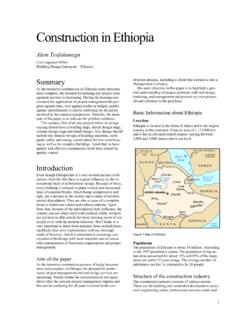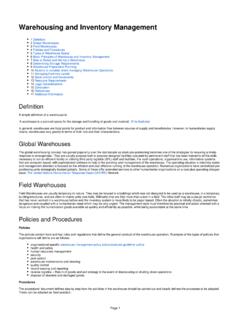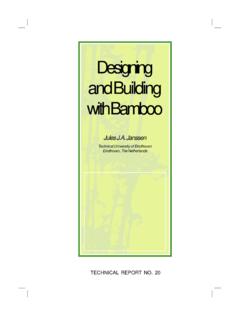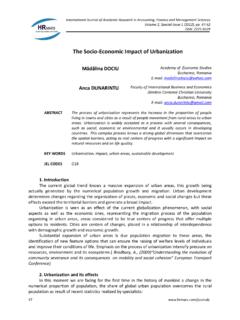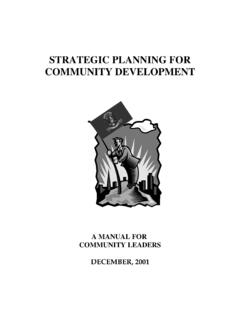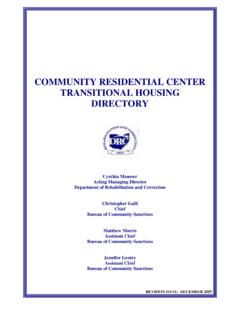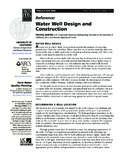Transcription of CONDOMINIUM HOUSING IN ETHIOPIA - Humanitarian …
1 United Nations Human Settlements Programme (UN-HABITAT) Box 30030, Nairobi 00100, KENYATel: +254 20 762 3120 Website: Since 2005 ETHIOPIA has been implementing an ambitious government-led low- and middle-income HOUSING programme: The Integrated HOUSING Development Programme (IHDP) which aims to construct 400,000 HOUSING units, create 200,000 jobs, promote the development of 10,000 micro- and small- enterprises, and enhance the capacity of the construction authoritative book documents the genesis of the programme and the country s experience since its inception. As it is intended for policy makers, public sector officials, and urban and HOUSING practitioners, it logically outlines the design of this programme and its effect on the multiple dimensions of HOUSING . Through documenting the Ethiopian experience other developing countries with HOUSING shortages and who face rapid urbanization and population growth can adapt and apply this logic to their own HOUSING systems.
2 In light of ETHIOPIA s previously uncoordinated and inefficient HOUSING sector, the Integrated HOUSING Development Programme has proved to be a highly successful tool for affordable HOUSING delivery at a large scale. Importantly, the programme is not only a HOUSING programme but a wealth generation programme for low-income households. Its success lies in its integrated nature - understanding HOUSING as part of an integrated social, economic, and political system - which has the opportunity to greatly improve the living conditions and economic capacity of all sectors of society. SUMMARYCONDOMINIUM HOUSING IN ETHIOPIA :European CommissionThe Integrated HOUSING Development ProgrammeSeries Summary: HOUSING Practices: country experiences of designing and implementing affordable HOUSING programmesHousing Practices is an ongoing series that documents the experiences of countries who are implementing large-scale affordable HOUSING programmes.
3 It is a flagship series developed and produced by the HOUSING Policy Section of UN-HABITAT, which provides authoritative and independent documentation of innovative affordable HOUSING programmes in countries of the developing than drawing from theory or abstract models, HOUSING Practices addresses the demand for practical guidance on HOUSING programmes based on experience. Each volume holistically documents one best-practice HOUSING programme that has achieved significant results. The volumes are thoroughly researched and presented in a way that clearly communicates the country s HOUSING sector context, the elements of the programme, key achievements and challenges, and suggestions for further programme improvement. Disseminating up-to-date information on country-specific large-scale HOUSING programmes is vital to reveal to other developing countries the programmatic opportunities for addressing their HOUSING shortages, reducing slum formation and growth, and improving the HOUSING conditions of their citizens.
4 Copyright United Nations Human Settlements Programme (UN-HABITAT), 2011 All rights reserved United Nations Human Settlements Programme (UN-HABITAT) PO Box 30030, Nairobi, Kenya Tel: +254 2 621 234 Fax: +254 2 624 266 may be reproduced without authorization, on condition that the source is indicated:UN-HABITAT (2010) The ETHIOPIA Case of CONDOMINIUM HOUSING : The Integrated HOUSING Development Programme. United Nations Human Settlements Programme: Nairobi. HS Number: HS/023/11 EISBN Number (Series): 978-92-1-132033-6 ISBN Number (Volume): 978-92-1-132326-9 DISCLAIMER The designations employed and the presentation of the material in this publication do not imply the expression of any opinion whatsoever on the part of the Secretariat of the United Nations concerning the legal status of any country, territory, city or area, or of its authorities, or concerning delimitation of its frontiers or boundaries, or regarding its economic system or degree of development.
5 The analysis, conclusions and recommendations of the report do not necessarily reflect the views of the United Nations Human Settlements Programme, the Governing Council of the United Nations Human Settlements Programme or its Member States. Photos: UN-HABITAT / Katherine Hegab Editor: Roman Rollnik, Matthew French and Ellen Daltrop Cover Design and Layout: Gideon MureithiPrinting: UNON, Publishing Services Section, Nairobi, ISO 14001:2004-certified. acknowledgementsThis report was prepared by Matthew French and Katherine Hegab from the HOUSING Policy Section, UN-HABITAT. Katherine Hegab and Rasmus Precht undertook the UN-HABITAT mission to Addis Ababa where they conducted research through site-visits, interviews with key stakeholders and household surveys on CONDOMINIUM sites. Claudio Acioly, Christophe Lalande and Rasmus Precht from HOUSING Policy Section, UN-HABITAT, supervised and finalised all outputs of this project.
6 Valuable comments were provided by UN-HABITAT s Regional Office for Africa and the Arab acknowledges the contribution of all individuals and organisations whose names are listed below. In addition to those mentioned here, appreciation is given to the households who participated in the household surveys undertaken in Bole Gerji and Arkebe, Abraham Tekeste, Amare Asgedom, Manuela Graetz, Sissay Dejene, Tadesse G. Gtorgis, Getachew Erieso, Yassin Morku, Tenadem Zewdie, Yemane Tsegaye, Lealem Berhanu, Yigzaw Mekonnen, Tsedale Mamo, Wendwosen Demerew, Mesfin Ayalew, Esrael Tesfaye, Belaynesh Teklay, Tewodros Tigabu Alemu, Mesele Haile, Alessandra Tisot, Esayas Abebe, Mesfin Assefa, Abay Mehari, Yoseph Tesfaye, Mahlet Mekonnen, Tamrat G. Giorgis, Nigel Browne, Solomon Keffa, Matthew French, Christophe Lalande, Rasmus Precht, Ellen Daltrop. This publication was funded by the Participatory Slum Upgrading Programme (PSUP), a joint initiative by the European Commission and the African, Caribbean and Pacific (ACP) Secretariat and implemented by HOUSING programme: etHiopiaiiContentscontentsiiacknowledgem ents itaBle oF contents iilIst oF taBles iiilIst oF FIgURes iveXecUtIVe sUmmaRY viiPaRt one.
7 THe etHIoPIan HOUSING sectoR 1 introduCtion to ETHIOPIA 1 BrieF HistorY oF Land and HOUSING in ETHIOPIA 2 Current state oF tHe HOUSING seCtor 4 poLiCY and LegaL FrameWorKs reLated to HOUSING 4 KeY pLaYers in HOUSING 4 HOUSING stoCK 5 HOUSING needs and eFFeCtiVe demand 6 urBan inFrastruCture and BasiC urBan serViCes 7 HOUSING FinanCe 7 ConstruCtion industrY and BuiLding materiaLs 7 Cross-Cutting issues 9 Current LoW-inCome HOUSING approaCHes 9 tHe Vision oF tHe integrated HOUSING deVeLopment programme 10 PaRt two: tHe IntegRated HOUSING deVeloPment PRogRamme 13 oVerVieW, origins and signiFiCanCe oF tHe programme 13 programme design 15 institutionaL FrameWorK 15 LegaL FrameWorKs 17 programme FinanCe 17 LoCation oF proJeCts 19 Consistent proJeCt speCiFiC Features 20 CONDOMINIUM HOUSING tYpoLogies 20 CommerCiaL units 22 CommunaL BuiLdings 22 Costing, QuantitY surVeYing and ConstruCtion 24 target BeneFiCiaries and unit aLLoCation 26 proJeCt design 27 an oVerVieW oF proJeCts 27 proJeCt design and impLementation 27 site seLeCtion 27 preLiminarY site and HOUSING unit design 28 Land CLearanCe, Compensation.
8 TemporarY resettLement 28 ConstruCtion ContraCtor engagement 28 ConstruCtion stage 29 unit aLLoCation and transFer 29 post-oCCupanCY stage 30 Case studies 31 BoLe gerJi tHe CONDOMINIUM piLot proJeCt 31 Lideta tHe First inner-CitY reLoCation proJeCt in addis aBaBa 31iiiCondominium HOUSING in etHiopialIst oF taBlestable 1: Houses constructed in addis ababa, 1996-2003 4table 2: planned CONDOMINIUM HOUSING unit construction, 2006-2010 11table 3: initial financial structure for beneficiaries according to unit type 19table 4: Breakdown of unit typologies in each CONDOMINIUM block 21table 5: unit type and beneficiary income level 26 PaRt tHRee: PRogRamme PeRFoRmance 37 antiCipated resuLts and aCHieVements 37 impaCt on CountrY 37 Large sCaLe and LoW Cost 37 urBan and HOUSING deVeLopment 38 unantiCipated resuLts and aCHieVements 38 HigH demand and support For tHe programme 38 LoW-inCome LandLords 38 Land and rentaL HOUSING marKet 39 unantiCipated CHaLLenges FaCing tHe programme 39 aFFordaBiLitY 40 programme FinanCing 40 BeneFiCiarY ConsuLtation and management 41 proJeCt speCiFiC issues 41 post-oCCupanCY issues 43 PaRt FoUR.
9 KeY lessons and conclUsIons 47 KeY Lessons 47 suggestions For improVement 47 aFFordaBiLitY 47 inFormation, ConsuLtation and Compensation in tHe resettLement proCess 48 design and ConstruCtion improVement 48 post-oCCupanCY 48 ConCLuding remarKs an aCHieVement WitH positiVe side eFFeCts and sCope For FurtHer improVements 49 BIBlIogRaPHY 50ivlIst oF FIgUResLIst oF FIGURes, BoXes AnD ACRonYMsFigure 1: Bole gerji: the pilot project for CONDOMINIUM HOUSING in ETHIOPIA viFigure 2: addis ababa is rising from a city of two-storey buildings to a city of skyscrapers. Bole, addis ababa viiiFigure 3: Kebele HOUSING , addis ababa 3 Figure 4: market street, addis ababa 3 Figure 5: the colossal CONDOMINIUM site of Jemo i, ii, and iii. addis ababa 12 Figure 6: the hills of addis ababa 5 Figure 7: the physical form of HOUSING in ETHIOPIA is predominantly single-storey 6 Figure 8: small-scale enterprise in addis ababa 7 Figure 9: Chikka : the traditional construction material for residential construction 9 Figure 10: Construction methods in ETHIOPIA are labour intensive 9 Figure 11: multi-storey buildings in addis ababa are typically constructed from cast in-situ reinforced concrete frame with brick infill walls 9 Figure 12: CONDOMINIUM HOUSING of the integrated HOUSING development programme.
10 10 Figure 13: Jemo CONDOMINIUM site, addis ababa 22 Figure 14: institutional framework (national (mWud) and in addis ababa) 16 Figure 15: Bole summit, the last CONDOMINIUM site to be built on the periphery of the city addis ababa 18 Figure 16: project sites include unit blocks arranged around outdoor green space. sengatera Ldp 1 20 Figure 17: CONDOMINIUM models at the Hdpo Headquarters 21 Figure 18: Bole summit under construction. addis ababa 22 Figure 19: Finished condominiums in mikililand, addis ababa 22 Figure 20: CONDOMINIUM block typical floor plan, snnpr. me engineering 23 Figure 21: CONDOMINIUM block elevation, snnpr. me engineering 24 Figure 22: CONDOMINIUM sites include commercial units at ground level in an effort to create mixed-use environments. mikililand CONDOMINIUM site, addis ababa 25 Figure 23: a communal unit in Bole summit, addis ababa 26 Figure 24: national distribution of CONDOMINIUM projects across the nine regional states of ETHIOPIA 28 Figure 25: Lideta site being cleared 29 Figure 26: Construction of Bole summit, addis ababa 29 Figure 27: Quality checks on building materials are crucial to ensure a high-quality result Lideta, addis ababa 30 Figure 28: Workman applying plaster to the first-storey of a CONDOMINIUM block Bole summit, addis ababa 30 Figure 29: Lottery winners are announced around the city.
